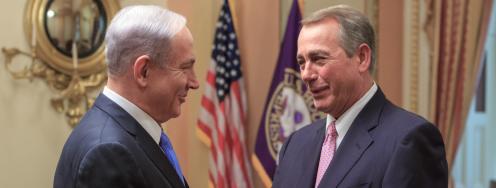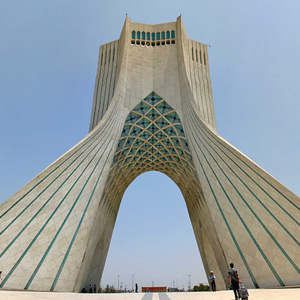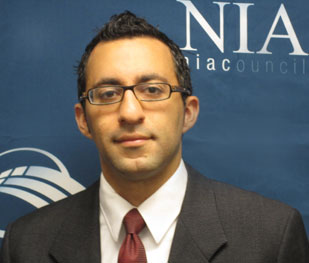Getting an Effective Deal with Iran: More than Just Centrifuges
On the radar: Opening on centrifuges; Rouhani’s house of cards; Iran tops 2015 agenda; GOP driving new sanctions; Blimps make a comeback; and Nuclear Sherlock Holmes.
January 7, 2015 | Edited by Jacob Marx and Will Saetren
The centrifuge obsession - “Centrifuges can be counted, so they have become an easy measure of whether any prospective deal would be tough or soft, a victory or a loss for either side. Yet these specific numbers -- which have proved the most difficult issue to resolve -- are not the most important elements for a final deal,” write the editors of Bloomberg View in response to a recent speech by Iranian President Hassan Rouhani that downplayed the importance of centrifuge numbers in a nuclear deal.
--“For the P5+1's goal of ensuring Iran never makes a nuclear weapon, it is less important to insist on a certain number of centrifuges than to secure a long-term agreement” moving Iran’s enriched uranium abroad and putting in place an exhaustive inspections regime.
--If negotiators are to get an agreement by their March time frame, “both sides need to start looking beyond red lines on centrifuge counts and work toward an effective agreement.” Read the editorial here. http://bv.ms/17iDSZM
--See also: “Rouhani's Big Gamble,” by Fred Kaplan in Slate. http://slate.me/1xBWttq
Talks continue - The P5+1 and Iran will resume talks over Iran’s nuclear program in Geneva on January 18 reports Adrian Croft for Reuters. In a statement released on Wednesday the EU said that the next round of talks “will be at political directors' level, chaired by EU Political Director Helga Schmid." Full story here. http://reut.rs/1zTNEbz
Analysis - What does Rohani’s call for possible referendums on key issues and openness on nuclear negotiations mean? As Alireza Nader of the RAND Institute tells RFE/RL, "While Rouhani controls the executive branch, the rest of the establishment is out of his control. So he has to appeal to the public which voted for him, and he is using popular opinion as a weapon. He may not intend to hold a referendum, but may see the threat of doing so as a deterrent against the conservatives." Full story by Golnaz Esfandiari. http://bit.ly/14nURYS
Top priority - Securing a nuclear deal with Iran tops the list of President Obama’s 2015 foreign policy objectives writes Robin Wright in The Wall Street Journal. “A deal would end 36 years of tension between Washington and Tehran that has played out across the Middle East…[and] check a nuclear arms race in the world’s most volatile region.” Full column here. http://on.wsj.com/1IqvfaJ
Tweet - @DavidCulpDC: Pope on nukes makes Esquire http://bit.ly/141yFTL
Congressional confrontation - “Congressional Republicans have long railed against President Obama's approach to nuclear negotiations with Iran.” As Kaveh Waddell reports for National Journal, “Now that the GOP has control of both the House and Senate, they're preparing to confront him on the matter this month.” Full story here. http://bit.ly/1tJxEXp
--See also: “New Iran Sanctions Bill Would Tie Penalties to Progress in Nuclear Talks,” by Rachel Oswald for CQ Roll Call (paywall). http://bit.ly/1tJDGqV
The Song Remains the Same - “Which notion is really the more bizarre? Which is dumber? That Moscow and Washington could resume efforts to reduce shared nuclear dangers? Or that the parties should be sending submarines bearing nuclear-armed cruise missiles to lurk off each other’s coasts, while building their own radar-blimps and Doomsday machines?” Jeffrey Lewis analyzes the strange case of the JLENS blimps deployed over Baltimore in this Foreign Policy piece. http://atfp.co/1DixnDo
Quick Hits:
--“Does North Korea have missiles that reach the U.S.?” Report from CNN featuring commentary by Paul Carroll of the Ploughshares Fund. http://cnn.it/1DvGVbv
--“Air Force adds airmen to nuke security forces teams” by Brian Everstine for the Air Force Times. http://bit.ly/1BHWtY8
--“Here's Why North Korea May Still Be Selling Weapons To A US Ally,” by Armin Rosen for Business Insider. http://read.bi/1wUJMEW
--“Iran must immunize itself against nuclear sanctions: Khamenei,” by Parisa Hafezi for Reuters. http://reut.rs/1tOJq8t
Events:
--“Preventing a Nuclear-Armed Iran through Diplomacy,” webinar by Women's Action for New Directions, featuring Kelsey Davenport of ACA and Jamal Abdi of NIAC. Wednesday January 7 at 2:00 PM. Register here.
--"WMD Terrorism and the American Response." Featuring Brad Hammitt of the National Nuclear Security Administration. January 8 at 4:30p.m. Off the record. Located at the Institute of World Politics, 1521 16th St. NW, Washington. RSVP online.
--“The Endgame: Success or Failure in Iran Nuclear Talks?" Featuring Ambassador Bill Luers, Paul Pillar, and Robin Wright of The Iran Project. January 12 from 4:30p.m.-6:00p.m. Located at Georgetown University’s Mortara Center for International Studies, 3600 N St. NW, Washington. RSVP online.
--“Strategic Deterrence in the Twenty-First Century." Featuring Adm. Cecil Haney, Commander, U.S. Strategic Forces. January 15 at 9:30 a.m.. Located at the Atlantic Council, 12th Floor, 1030 15th St. NW, Washington. RSVP online.
--“Strategic Deterrence in 2015 and Beyond," featuring Maj. Gen. Garrett Harencak, Air Force Assistant Chief of Staff for Strategic Deterrence and Nuclear Integration. January 20, 7:00-9:00 a.m. Sponsored by the Air Force Association. Key Bridge Marriot, 1401 Lee Highway, Arlington, VA. RSVP online.
Dessert:
It’s elementary, my dear - “If federal agents ever capture a stolen nuclear weapon — or have to investigate the detonation of one — they will turn to one of the most esoteric groups of detectives in the world,” writes Ralph Vartabedian for the Los Angeles Times.
--“Radioactive fallout from a weapon would provide important clues, as might a suspected smuggler's fingernails or hair. Atomic analysis of chemical traces left in the human body from exposure to different environments might show that a suspect spent time in Kabul, Afghanistan; Tehran; or Pyongyang, North Korea...“That's the aim of scientists at the Energy Department's Oak Ridge National Laboratory, which is researching how the human body stores trace chemicals unique to different parts of the world.” Full story here. http://lat.ms/1yAGzRV



